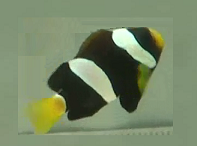Clown Fish is considered a hardy marine species requiring moderate care and attention and they are always an automatic choice, often added to a newly set up fish tank. The fish is regarded as one of the favorite family pets popular among kids and they are widely known as the icon from the movie Nemo. Depending on the level of knowledge that the fish keeper has, clown fish can be quite relatively easy to handle but often proves to be extremely difficult especially for newcomers with no prior experience in saltwater aquarium.
Clown fish is also one of the most ever demanding community species when it comes to making them adapt to an existing community tank with different fish mainly because of their unpredictable behavior especially with their interaction with the other species. In the past, most wild caught clown fish are extremely difficult to ensure that they survive and live long enough in home aquariums mainly because of the symbiotic relationship that require the anemones (which is an invertebrate sea creature with tentacles) to be present. However today, things have changed as the new generations of tank-bred fish no longer need the anemones around although it does help to have the invertebrates to keep them company.
Mixing clown fish to an existing aquarium seems to be more difficult. As explained previously their behavioral change can be of a sudden. Thus, in order to avoid all these problems, you should only introduce your clown fish when they are juvenile yearling and there are certain rules regarding the type of fish that they can live together with. So far, cardinalfish, damselfish, royal gramma are the best companions for them while hawkfish, predatory lionfish and moray eels are definitely out of the question. Further to that, mixing between different species of clown fish won't work as they will fight to claim their territory and so far, according to science journals, there are at least 25 different species altogether that has been identified till date. Therefore, do not make a wrong decision and conclusion thinking that all clown fish are the same. In order to help you to identify which group your clown fish belongs to and to avoid mixing between different species, hopefully the attached pictures in the table above will help you to make a wise decision.
Raising Clownfish – choice of either making a single species tank or community aquarium
There are two different options as to how you want to raise the fish which is to either keep them in a single species tank or get them to acclimatize to an existing community aquarium. Generally the captive-raised clown fish if properly fed and cared for can easily grow up to 3 inches in length and the size will vary depending on the type of species that you own. If you have a saltwater marine aquarium (>100 gallons) large enough to accommodate at least 3 to 4 of the same species, then I would suggest buying them in groups when they are small (about a year old) so that when they grow up, chances for any two fish to become a breeding pair is much higher. Although not compulsory, somehow doing this will ensure that there is certain level of competition among the group to survive and this also help them to have social interaction with each other as well. As they grow older, one of the larger and dominant clown fish will become the female and turns out to be the leader. After bonding as a pair with another male, it is time to remove the other clown fish as the pair will do their best to defend their chosen territory. |  |  |
| Maroon Clownfish is easily identified based on their bright red coloration with thin vertical white stripes. The dorsal and ventral fins are split into two parts. | Tomato Clownfish is the cutest of all and it appears orangery with presence of only one vertical strip close to the gills. | Orange-finned clown fish is the most brightly colored of all the Amphiprion species. It has blue stripe against a dark orange backdrop and has yellow fins |
 |  |  |
| Unlike the rest of the clownfish species which has thin white vertical stripes across its body, the Ocellaris Clown fish has wide expanded bands appearing at the center of its body with the orange backdrop. | The Percula clown fish look almost identical to the Ocellaris except that it has additional black color shades and bands appearing between the white stripe. | Clarkii or sometimes called Clark's clown fish is recognizable based on its two white colored bands on its dark body. The mouth and tail fin are yellow though. |
Finally if you are an experienced hobbyist knowing the ins and outs of maintaining a freshwater tank, then I would suggest getting a saltwater aquarium with the clown fish to start with. One thing I can tell you is that your kids of definitely love them. If clown fish is not your idea of an ideal aquarium fish then I would suggest reading this article for the list of recommended best pet fish for kids.

No comments:
Post a Comment